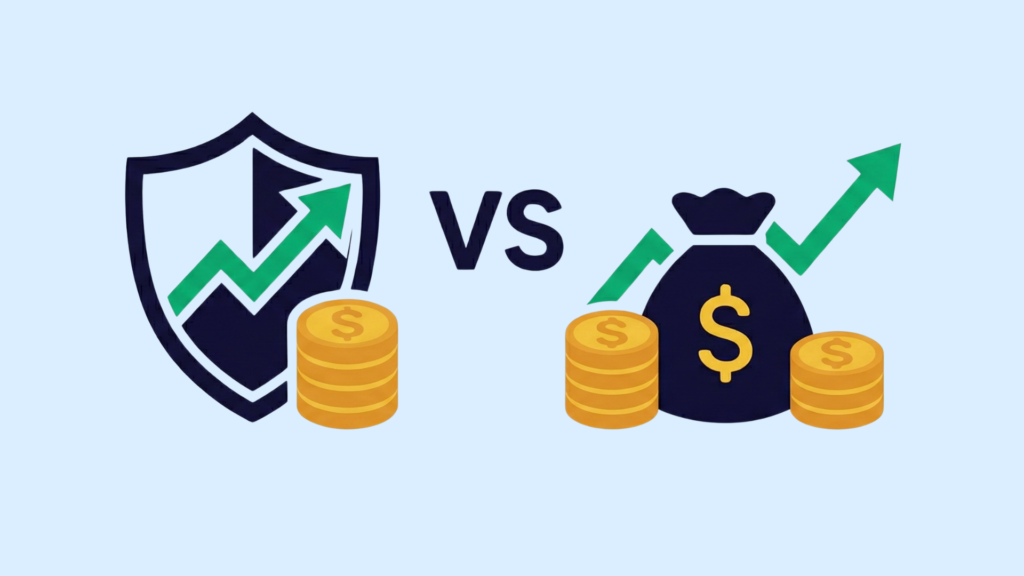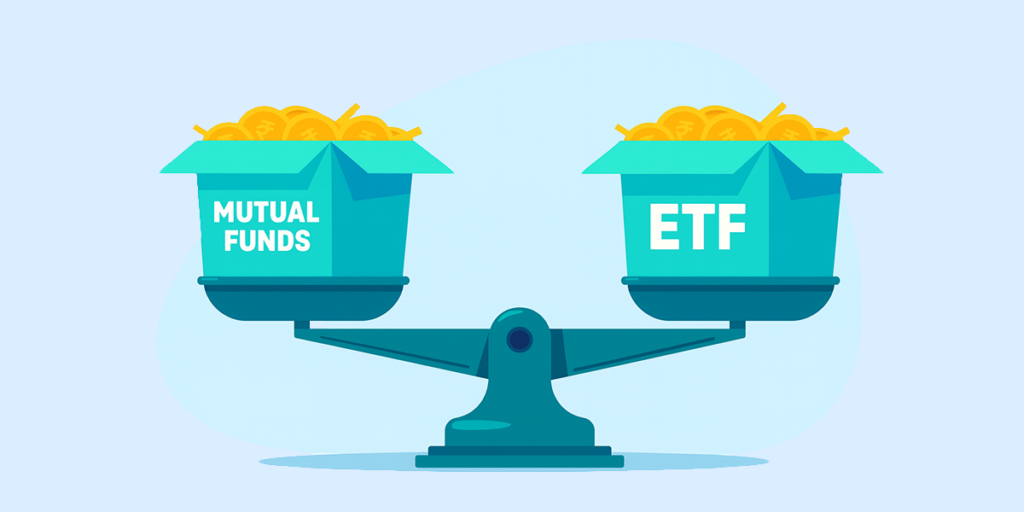When it comes to saving and investing money, Indians often come across two very different choices: chit funds and mutual funds. While both involve pooling money from a group of people, their purpose, structure, and potential outcomes are very different.
Chit funds are more like community-based savings schemes, where members contribute regularly and take turns accessing the pooled amount. On the other hand, mutual funds are regulated, professionally managed investments that put your money into stocks, bonds, or other assets to generate returns.
In this blog, we’ll break down how each works, its advantages and risks, and which option might suit your financial goals best.
What is a Chit Fund?
A chit fund is a traditional savings and borrowing scheme widely used in India. In simple terms, it’s both a savings plan and a source of credit within a group of people.
How Chit Fund Works
- A group of members contribute a fixed amount every month into a common pool.
- During each cycle, the collected amount (called the “chit”) is auctioned or given to one member, usually through a bidding process.
- The member who bids the lowest for the prize money gets it, while the remaining amount is distributed as savings for others.
- This process continues until every member has received the prize money once.
Legal Framework
Chit funds in India operate under the Chit Fund Act, 1982, which governs registration, rules of operation, and safeguards for subscribers. However, only registered chit funds are legal. Unregistered or private chit groups are risky and often unregulated.
What is a Mutual Fund?
A mutual fund is a professionally managed investment vehicle where money from many investors is pooled together and invested in financial instruments like stocks, bonds, and money market securities.
Unlike chit funds, which operate on a savings-borrowing mechanism, mutual funds give you market-linked returns. If you’re just getting started and are unsure about large lump-sum investments, our Daily SIP at just ₹11 a day offers a practical, low-cost entry point to start building your portfolio through mutual funds. This small, consistent investment strategy enables you to grow your wealth over time, leveraging the power of compounding.
Types of Mutual Funds
- Equity Funds: Invest in company shares and is best for long-term wealth creation.
- Debt Funds: Focus on fixed-income securities like bonds; these are best suited for conservative investors.
- Hybrid Funds: Mix of both equity and debt, balancing growth and stability.
- Index Funds: Passively track a benchmark index like Nifty 50 or Sensex.
Regulation
Unlike chit funds, mutual funds in India are strictly regulated by the Securities and Exchange Board of India (SEBI). This ensures transparency, investor protection, and compliance with reporting standards.
Chit Funds vs Mutual Funds: Key Differences
When choosing between chits vs mutual funds, the biggest difference is regulation and investment style. Mutual funds are market-linked and professionally managed, whereas chit funds work on pooled savings and borrowing within a group.
| Aspect | Chit Fund | Mutual Fund |
| Nature of Investment | Works as a savings-and-borrowing system among group members. Returns depend on bidding/auction. | Market-linked returns through investments in equity, debt, or hybrid instruments. |
| Regulation & Transparency | Governed by the Chit Fund Act, 1982 and state laws. Less transparent and prone to misuse if unregistered. | Strictly regulated by SEBI, ensuring higher transparency, disclosures, and investor protection. |
| Risk & Returns | Returns vary, are often unpredictable, and depend on participation. Risk of fraud in unregistered schemes. | Market risks apply, but returns can be more stable and wealth-building over the long term. Professional fund management reduces risk. |
| Liquidity & Accessibility | Limited liquidity. Investors get access to funds only during their turn in the cycle. | Highly liquid. Units can be redeemed anytime in open-ended funds at the prevailing NAV. |
| Suitability | Suitable for small savers looking for a mix of savings and short-term borrowing. | Suitable for investors with financial goals, seeking long-term growth or stable income. |
Advantages and Risks of Chit Funds
Chit funds are often seen as an informal savings tool in India, especially in smaller towns and semi-urban areas. While they provide some benefits, they also carry notable risks.
Advantages of Chit Funds
- Easy access: Anyone can participate without needing a Demat or trading account.
- Flexible savings option: Participants contribute fixed amounts monthly, making it simple to maintain.
- Borrowing support: Members can bid for funds early if they need lump-sum money which makes it very useful for emergency requirements.
Risks of Chit Funds
- Fraud risk: Unregistered chit funds are often prone to scams, and investors can lose their money.
- Lack of guaranteed returns: Earnings depend on bidding, so there’s no fixed return like FDs or bonds.
- Default by members: If participants delay or stop contributing, it can disrupt payouts.
To reduce risks, it’s safer to opt for registered chit funds like those run by State-run Chit Corporations (e.g., Kerala State Financial Enterprises, Mysore Sales International) or reputed private chit firms that follow the Chit Funds Act, 1982.
Advantages and Risks of Mutual Funds
Mutual funds are a far more structured and regulated investment option, making them popular for long-term wealth creation.
Advantages of Mutual Funds
- Professional management: Expert fund managers manage your money and track markets daily.
- Diversification: A single investment spreads risk across multiple stocks, bonds, or asset classes. Through our Daily SIP at ₹11, you can diversify across various asset classes, whether equity, debt, or hybrid, even with minimal capital, ensuring that your money is spread across different market segments.
- Regulated by SEBI: Strong regulatory oversight gurantees transparency, investor protection, and accountability.
Risks of Mutual Funds
- Market volatility: Returns changes based on stock or bond market performance.
- Expense ratio: Fund management fees can lower overall returns, especially in actively managed funds.
- Exit loads: Some funds charge a penalty if you redeem your investment within a short time frame.
Which is Better: a Mutual Fund or a Chit Fund?
When comparing mutual funds and chit funds, the choice depends on what you want to achieve and how much risk you’re comfortable with.
- For wealth creation: Mutual funds are better suited. They offer diversification, professional management, and regulated structures under SEBI. Over the long term, they can yield better returns through market participation.
- For short-term cash rotation or savings: Chit funds may work if you’re looking for periodic access to lump sums. They function more as a community savings system than an investment vehicle.
Did you know?
US ETFs (Exchange Traded Funds) offer a great opportunity for investors looking to diversify their portfolio with international exposure. With Appreciate, you can now access these ETFs easily, benefiting from the growth of US-based companies. Investing in US ETFs can be a strategic way to tap into global markets, adding stability and potential growth to your investment strategy.
FAQs
What is a chit fund, and how does it work?
A chit fund is a type of savings scheme where a group of people contribute a fixed amount every month. In each cycle, one member takes the pooled amount through a bidding process or a lucky draw. This continues until every member has received the prize once. That’s the simple mechanism of how a chit fund works.
What is the difference between a chit fund and a mutual fund?
The difference between a chit and a mutual fund lies in their purpose and structure. A chit fund is mainly a savings-and-credit arrangement with no guarantee of returns. In contrast, a mutual fund is a regulated investment that pools money to invest in stocks, bonds, or other assets for generating market-linked returns.
Are chit funds safe compared to mutual funds?
Chit funds carry higher risks compared to mutual funds because many are unregulated and prone to defaults or fraud. Mutual funds, on the other hand, are monitored by SEBI, which makes them far more transparent and reliable for investors.
Which is better for investment: chit funds or mutual funds?
If your goal is wealth creation, mutual funds are better because they provide diversification, professional management, and regulatory safety. Chit funds are not ideal for investment; they are more of a traditional savings tool.
What are the best chit funds in India?
The best chit funds in India are those registered and regulated under the Chit Funds Act, 1982. Some examples include government-backed chit companies like Kerala State Financial Enterprises (KSFE) and reputable private chit firms that follow compliance norms.
Disclaimer
The information provided in this article is for educational and informational purposes only. It should not be considered as financial or investment advice. Investing in stocks involves risk, and it is important to conduct your research and consult with a qualified financial advisor before making any investment decisions. The author and publisher are not responsible for any financial losses or gains that may result from the use of this information.























